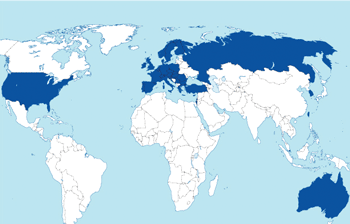The Enabling Grid for E-sciencE project (EGEE) is Europe’s flagship Research Infrastructures Grid project1 and the world’s largest Grid infrastructure of its kind. It involves more than 70 partners from 27 countries, arranged in 12 regional federations, and providing more than 16,000 CPUs, more than 160 sites and 10 petabytes of available network storage. This infrastructure supports six scientific domains and more than 20 individual applications.
Started in March 2004, EGEE has rapidly grown from a European to a global endeavour, and along the way learned a great deal about the business of building production-quality infrastructure. The consortium behind this effort represents a significant proportion of Europe’s Grid experts, including not only academic intuitions but also partners from the Research Network community and European industry. This article outlines the project’s structure and goals, its achievements and the importance of cooperation in such large scale international efforts.
 The aim of EGEE is to leverage the pre-existing grid efforts in Europe, thematic, national and regional, to build a production quality multi-science computing Grid. As a result, the primary objective is to build the infrastructure itself, connecting computing centres across Europe (and more recently, around the globe) into a coordinated service capable of supporting 24/7 use by large scientific communities. To support this production service, the project also aims to re-engineer existing middleware components to produce a service-orientated middleware solution. Finally, the project aims to engage the maximum number of users running applications on the infrastructure through dissemination, training and user support. These tasks have been divided into different activity areas, which are tackled by different groups within the project. These groups are distributed across a number of partner institutes with relevant experience, such that the project helps to connect its partners and encourage knowledge transfer in the process of achieving its goals.
The aim of EGEE is to leverage the pre-existing grid efforts in Europe, thematic, national and regional, to build a production quality multi-science computing Grid. As a result, the primary objective is to build the infrastructure itself, connecting computing centres across Europe (and more recently, around the globe) into a coordinated service capable of supporting 24/7 use by large scientific communities. To support this production service, the project also aims to re-engineer existing middleware components to produce a service-orientated middleware solution. Finally, the project aims to engage the maximum number of users running applications on the infrastructure through dissemination, training and user support. These tasks have been divided into different activity areas, which are tackled by different groups within the project. These groups are distributed across a number of partner institutes with relevant experience, such that the project helps to connect its partners and encourage knowledge transfer in the process of achieving its goals.






